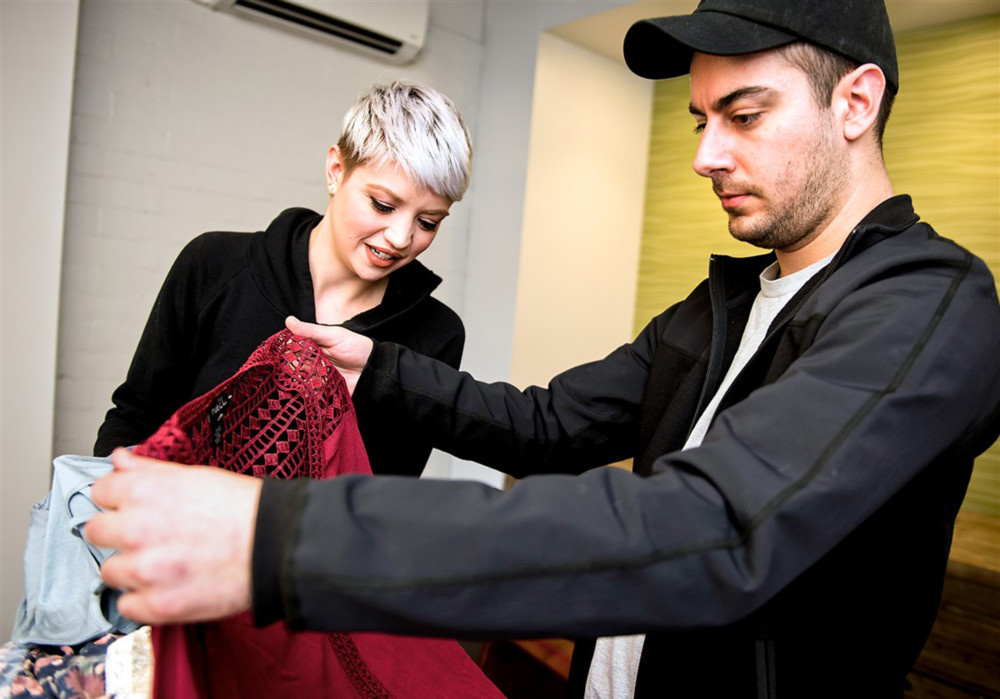By Sara Bauknecht
Pittsburgh Post-Gazette
WWR Article Summary (tl;dr) With “sizeless” clothing, women in recovery can focus on successfully transitioning back to their daily routines and maintaining a healthy lifestyle, without focusing on what size they’re wearing.
PITTSBURGH
An outfit that fits just right has the potential to empower. But the process of finding one, which often involves sorting through a dizzying sea of sizes that varies from brand to brand, can be overwhelming, particularly for someone who is recovering from an eating disorder.
That’s where Garment Project comes in. Erin Drischler and her fiance, Jordan Tomb, who live on the North Side, recently started the nonprofit that works with treatment facilities to provide outgoing patients with new sizeless clothing. That way, women in recovery can focus on successfully transitioning back to their daily routines and maintaining a healthy lifestyle, without focusing on what size they’re wearing.
“Coming home to my closet after multiple different treatment stays and my clothes were too big or too small, I used them as a tool to measure my weight or size.” says Drischler, who struggled with anorexia nervosa for 14 years. “My clothing didn’t necessarily keep me sick, but it was a constant reminder of the person I was with my eating disorder. Clothing also was a way I could transform myself to be the person I wanted to be.”
An estimated 20 million women in the United States have an eating disorder, Garment Project states on its website (www.thegarmentproject.org). Three in 100 American women have bulimia (extreme overeating then purging), while one in every 200 has anorexia (characterized by extremely low body weight), which has the highest mortality rate of any mental illness.
Treatment can cost up to $30,000 per month, making it challenging to afford new clothes after recovery.
With fiscal sponsorship from New Sun Rising (a local organization that supports solutions to social issues), the couple launched the project last month, timed with National Eating Disorders Awareness week, and were humbled by the positive responses they received.
One of the first retailers to reach out to them was Cranberry teen clothing chain rue21, which donated boxes of clothing to the cause. Before pieces are packed and shipped to treatment centers for distribution, all tags with sizing information will be removed. Those in recovery will get access to an individualized website where they can browse and select the clothes they like.
In addition to options for teenagers, Garment Project is seeking professional apparel and casual wear for adult women. While no clothing has been distributed yet, details are being worked out for a partnership with a national treatment center that would expand the group’s reach beyond the region.
About two years ago, Drischler and Tomb started to get serious about turning their ideas for the endeavor into a reality, a leap they felt their professional backgrounds equipped them to take.
Until the end of last year, Drischler worked full time at Nordstrom managing a few departments. She’s since scaled back her hours to focus on Garment Project. Tomb works for the marketing agency Deeplocal in the Strip District and uses his experience as a documentarian to chronicle their nonprofit’s journey.
Although Garment Project still is in its infancy, the path to this point has been a very personal one for its founders.
Drischler and Tomb met about five years ago while attending Point Park University and The Art Institute of Pittsburgh, respectively. When Drischler went to California for a treatment program, Tomb came along, too.
“Meeting Erin and becoming close with her was my introduction to this issue,” he says. “I went out to California and participated in some sessions with her and her team out there and tried to get more comfortable in this conversation.
buy prednisone generic buy prednisone online no prescription
”
Drischler is now two years into her recovery and is doing “phenomenally better,” her fiance says.
“I spent a lot of time really learning how to feel confident in speaking and taking up space and knowing that my voice mattered and I had something to offer,” she adds.
Sometimes, that meant tuning out the images on television, social media and in magazines that depict a narrow view of beauty and a woman’s body. She’s encouraged, though, by the “small steps toward improvement” that have cropped up in fashion campaigns and on the catwalk.
Lane Bryant, ModCloth and Aerie by American Eagle are some of the labels that have been at the forefront of incorporating women of more body types (and, in some cases, not retouching photos) in their ads.
Meanwhile, New York Fashion Week in February featured 26 plus-size models (up from 16 last September), according to the Fashion Spot’s latest Runway Diversity Report. (It was the city’s best season on record for including models of a range of sizes, although plus-size women still only made up fewer than 1 percent of all models cast.)
The couple hope Garment Project can spark more conversations about healthy relationships between fashion and body image, and maybe someday extend its services to include sizeless clothing for men in recovery, too.
“We’re really hoping people will be able to look past numbers and realize what else they have to offer versus the size they’re buying,” Drischler says.














































































































































































































































































































































































